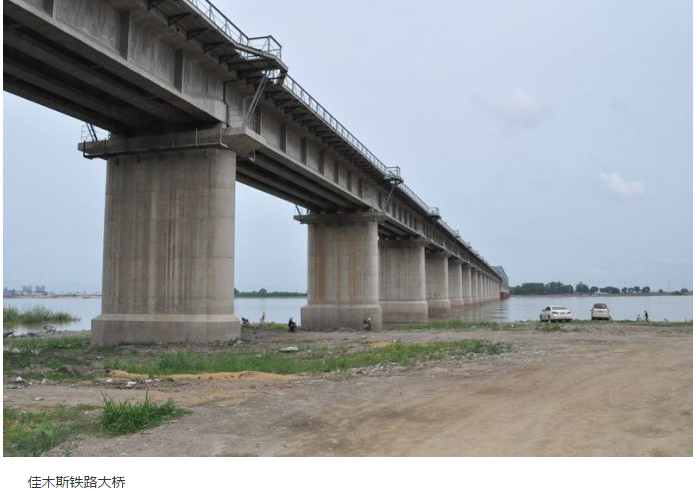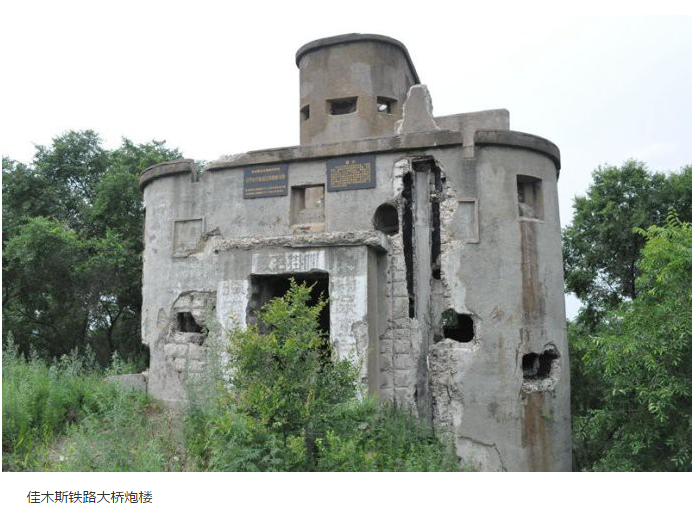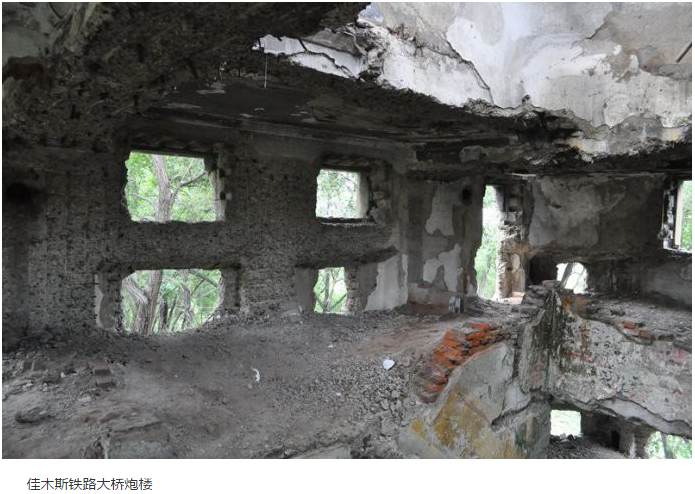《佳木斯铁路大桥炮楼》
- 2021-01-09 14:08:02
- 点赞量:9233
- 点击量:160621
- 作者:郝连成 Hao Liancheng

在佳木斯松花江铁路大桥的南北两端,当年日本,人修的两座炮楼象两颗溃烂干瘪的毒瘤一样让人看着心里别扭。
At the north and south ends of the Songhua River Railway Bridge in Jiamusi, the two turrets built by people in Japan at that time looked like two canker and withered tumors, which made people feel uncomfortable.
2014年的七、七事变纪念日,我又来到了这里,看着那残垣断璧和炮楼脚下日夜流淌的松花江水,遥想当年日本人扶持下的伪满州国在东北的统治,感慨桑田巨变,更加珍 惜现在的和平环境和安宁的生活。
On the anniversary of the July 7th incident in 2014, I came here again. Looking at the broken walls and the Songhua River flowing day and night at the foot of the turret, I thought about the puppet Manchukuo's rule in Northeast China under the support of the Japanese. I felt the great changes in Sangtian and cherished the peaceful environment and peaceful life.

在江南炮楼的东面的正门上边,钉着的两块牌子,左边的牌子上写着:
On the east main gate of Jiangnan turret, there are two signs nailed. The sign on the left reads:
佳木斯市文物保护单位
Jiamusi cultural relics protection unit
侵华日军松花江铁路桥头堡
The bridgehead of Songhua River Railway of Japanese invaders in China
佳木斯市人民政府2013年7月9日公布
Jiamusi Municipal People's government announced on July 9, 2013
佳木斯市人民政府2013年8月9日立
Jiamusi Municipal People's government was established on August 9, 2013
右边的“简介”牌子上写着:
The "Introduction" sign on the right says:
侵华日军松花江铁路桥头堡,分南北两座,是侵华日军修筑的军用设施。始建于1939年,1941年建成通车。
The Songhua River Railway bridgehead of the Japanese invaders, which is divided into North and south, is a military facility built by the Japanese invaders. It was built in 1939 and opened to traffic in 1941.
据说这个桥头堡是一名 日本刚毕业学生设计的,八十年代初她还专程回到佳木斯来看过这个桥头堡,那时保存的还完好无损,可惜现在已经面目全非了。
It is said that this bridgehead was designed by a Japanese fresh graduate. In the early 1980s, she went back to Jiamusi to see this bridgehead. At that time, it was still intact, but now it is beyond recognition.

现在的江桥在旧的日本铁路桥西约六七十米处,整栋炮楼全都是钢筋混凝土浇注,墙壁厚达半米,分地下室两层,地面三层,最顶层呈U型桶状该是嘹望用的,估计那时候,可以俯瞰佳木斯全城。踏着残缺的地面,我大约用步量了一下, 最大的房间面积是南北长15步,东西宽17步,我的一步大约是1米。 因此可算出除了顶层外,其他四层使用面积大约有500多平方米,驻扎一个中队的日本鬼子是没问题的。看来,日本人的军事工程设计,在那个年代是非常先进的,炮楼内部各个功能区域都跟完备,外观看着不大的建筑,里面却别有洞天。作战室、弹药库、宿舍、食堂、厕所一应俱全。通风口、烟道、嘹望口、射击口,遍布炮楼四周,光射击的机枪口,就分跪式的、俯卧式的,设计十分精致,视野里没有死角。
The current Jiangqiao is about sixty or seventy meters west of the old Japanese railway bridge. The whole building is made of reinforced concrete. The walls are half a meter thick. There are two basement floors and three floors on the ground. The top floor is in the shape of a U-shaped barrel. It is estimated that at that time, you can overlook the whole city of Jiamusi. Stepping on the incomplete ground, I measured it with steps. The largest room area is 15 steps long from north to South and 17 steps wide from east to west. My step is about 1 meter. Therefore, it can be calculated that in addition to the top floor, the other four floors have an area of about 500 square meters, and the Japanese devils stationed in a squadron have no problem. It seems that the Japanese military engineering design was very advanced at that time. The internal functional areas of the turret were relatively complete. The buildings with small appearance had unique holes inside. War room, ammunition depot, dormitory, canteen and toilet are all available. Vents, flues, lookout ports and shooting ports are all around the turret. The machine gun ports for light shooting can be divided into kneeling type and prone type. The design is very exquisite, and there is no dead angle in the field of vision.
环顾炮楼内部,从当年勾勒的棚顶来看,完全是日式风格,分成了格局不- -的小屋,各有各的用途吧!现在算来炮楼修建也有近80年了,看到现拆除门窗和里边钢筋的费劲儿就知道这炮楼的修筑质量。据说曾有人看到中国人建的豆腐渣工程时就说应让那些建筑商去松花江桥头看看那日本人留下的炮楼子。正因为修筑得质量好,才留下了这永久的实物,这是侵华日军的一个历史,是揭露日本侵华的又-罪证。 现在佳木斯市政府已做为历史文物保护起来了,更应进一步修缮整理出来,作为爱国主义教育基地来发挥作用。
Looking around the interior of the turret, it can be seen from the shed roof outlined at that time that it is totally Japanese style. It is divided into huts with different patterns, and each has its own purpose. Now it has been nearly 80 years since the construction of the turret, and the quality of the construction of the turret can be known by the difficulty of removing the doors, windows and internal steel bars. It is said that when someone saw the bean curd dregs project built by the Chinese, they said that they should let the builders go to the Songhua River Bridge to see the turret left by the Japanese. It is precisely because of the good quality of the construction that this permanent object is left behind. This is a history of the Japanese invasion of China and another criminal evidence to expose the Japanese invasion of China. Now that Jiamusi municipal government has been protected as a historical relic, it should be further repaired and sorted out to play a role as a patriotic education base.

郝连成2014-07-16佳木斯松花江畔
Hao Liancheng 2014-07-16 Jiamusi Songhua River






雁在蓝天